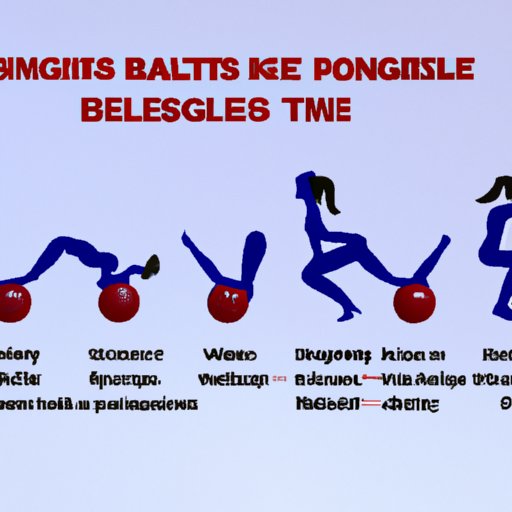Introduction
Kegel exercises are a type of exercise specifically designed to strengthen the pelvic floor muscles. These exercises can help improve bladder control, reduce urinary incontinence, and even give more satisfaction during sexual intercourse. While Kegel exercises were originally developed for women, men can also benefit from them too. In this article, we’ll explore what Kegel exercises are, the benefits of doing them, a step-by-step guide to performing them correctly, common mistakes to avoid, the best time of day to do them, and what to expect after doing them.
What are Kegel Exercises?
Kegel exercises were developed in 1948 by Dr. Arnold Kegel, an American gynecologist. They are a series of exercises designed to strengthen the pelvic floor muscles, which are the muscles that support the bladder, uterus, and rectum. The muscles are sometimes referred to as the “love muscles” because they play an important role in sexual pleasure. When these muscles are weak, it can lead to urinary incontinence, pelvic organ prolapse, and erectile dysfunction.

Benefits of Doing Kegel Exercises
The primary benefit of doing Kegel exercises is improved bladder control and reduced urinary incontinence. This can be especially beneficial for pregnant women who often experience stress incontinence due to weakened pelvic floor muscles. According to a study published in the International Urogynecology Journal, women who did Kegel exercises experienced a significant decrease in their urinary incontinence symptoms. Other potential benefits include improved sexual performance, improved bowel control, and reduced risk of pelvic organ prolapse.
Step-by-Step Guide to Kegel Exercises
Doing Kegel exercises is relatively simple, but it’s important to do them correctly in order to get the most benefit. Here’s a step-by-step guide:
How to Do Kegel Exercises
1. Start by sitting or lying down on your back with your knees bent and feet flat on the floor. It’s important to relax your body and not to tense any other muscles.
2. Squeeze the pelvic floor muscles for five seconds and then release for five seconds. Make sure you don’t hold your breath while squeezing.
3. Repeat this process 10 times.
How to Know You’re Doing Kegel Exercises Correctly
If you’re not sure if you’re doing Kegel exercises correctly, there are a few ways to check. One way is to insert a finger into the vagina and try to squeeze the muscles around it. If you feel a tightening sensation, then you’re doing the exercises correctly. Another way to check is to stop urinating midstream. If you can stop the flow of urine, then you’re doing the exercises correctly.
Common Mistakes to Avoid When Doing Kegel Exercises
While doing Kegel exercises is relatively simple, there are some common mistakes to avoid. Here are a few:

Not Relaxing During the Exercise
It’s important to relax your body when doing Kegel exercises. If you tense any other muscles, such as your stomach, buttocks, or thighs, then you won’t be exercising the correct muscles.

Doing Too Many Kegels at Once
It’s important to start slow and gradually increase the number of repetitions. Doing too many Kegels at once can cause the muscles to become overworked and can actually make the problem worse.

Doing Too Little or Too Much Pressure
When doing Kegel exercises, make sure you’re squeezing the pelvic floor muscles with just enough pressure. If you squeeze too hard, it can cause the muscles to become overworked. On the other hand, if you don’t squeeze hard enough, you won’t be exercising the muscles effectively.
The Best Time of Day to Do Kegel Exercises
There is no definitive answer as to when the best time of day to do Kegel exercises is. However, it’s generally recommended to do them at least three times per day. Some people find it helpful to do them in the morning, afternoon, and evening.
How Often to Do Kegel Exercises
In general, it’s recommended to do Kegel exercises at least four times per week. However, it’s important to listen to your body and adjust the frequency depending on how your body responds.
What to Expect After Doing Kegel Exercises
Once you start doing Kegel exercises regularly, you should start to notice some changes in your body. Here’s what to expect:
Long-Term Benefits
Over time, you should start to notice an improvement in your bladder control and a decrease in urinary incontinence. Additionally, you may also experience improved sexual performance and better bowel control.
Short-Term Benefits
In the short-term, you may notice improved muscle tone and increased blood flow to the pelvic area. This can result in improved sensation during sexual activity and a decrease in menstrual cramps.
Conclusion
Kegel exercises are a great way to strengthen the pelvic floor muscles, which can lead to improved bladder control and decreased urinary incontinence. They’re easy to do and can be done anytime, anywhere. To get the most benefit, it’s important to do them correctly and avoid common mistakes. With regular practice, you should start to see results in both the short-term and long-term.
Summary
Kegel exercises are a series of exercises designed to strengthen the pelvic floor muscles, which can help improve bladder control, reduce urinary incontinence, and even give more satisfaction during sexual intercourse. When done correctly, Kegel exercises can lead to both short-term and long-term benefits, including improved bladder control, increased sexual performance, better bowel control, and improved muscle tone.
Final Thoughts
Kegel exercises can be a great way to improve your overall health and well-being. So why not give them a try? With regular practice, you’ll be on your way to a stronger, healthier pelvic floor.
(Note: Is this article not meeting your expectations? Do you have knowledge or insights to share? Unlock new opportunities and expand your reach by joining our authors team. Click Registration to join us and share your expertise with our readers.)
